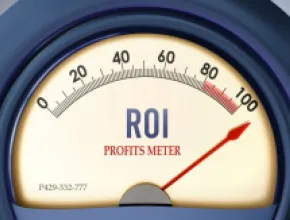The economy drones on, meetings budgets keep getting slashed, and planners face continuing pressure from stakeholders to prove value--of their meetings, events…and of themselves.
Inside this business climate, industry trainers on ROI (return on investment) technique and its sub-topics--ROO (return on objectives) and ROE (return on experience)--warn planners there may be no more important skill set in their professional quiver these days than that of proving value to stakeholders, something that’s under the umbrella of strategic meetings management (SMM).
Before the economy began to sputter a few years ago, and meetings cancellations and cutbacks became more common, many regarded demonstration of ROI optional. Meetings logistics are demanding, after all, and arranging them leaves little time for measurements. But the paradigm has changed.
“Measurement is no longer something that is nice to have,” says Cindy D’Aoust, vice president strategic meetings for Maxvantage and a speaker at HSMAI’s MEET National who delivered a “Demonstrating Meeting Effectiveness” session. “It’s needed. With budgets being scrutinized, meeting professionals and the business units they support need to know how to demonstrate the value meetings deliver both in finance terms and in business terms.”
Several industry organizations have done research that points to why return measurements are essential to today’s business processes.
One recent HSMAI survey found, for example, that 60 percent of meeting planners feel pressure to measure event satisfaction, attendance and net revenue. The bottom line is not the approach in today’s market, the research found. Rather, planner focus must be more strategic and take into account a balanced methodology, along with logistical and interpersonal aspects of events. PageBreak
Returns Defined
Jack Phillips, chairman of the ROI Institute, developed the ROI Methodology and acknowledges common confusion about return terms.
“When you use the word ‘return’ on something, your accounting department gets involved,” Phillips says. “We should just call it ‘reaction’--as in measuring satisfaction after your meeting. That’s the first level in the ROI Methodology. The second is learning. What do your attendees now know that they didn’t know before they came to your meeting? The third is application: What will they do with what they took away from your meeting? And the fourth is impact: the consequence of that application. Those four levels of objectives are part of the ROI Methodology. The fifth level is where we take the impact measure and compare it to the cost of the event. Only a few events need to be taken to that level.”
ROO, he said is a fundamental part of ROI. Work objectives are set and data are collected to determine if the objectives are met.
Hugh K. Lee, president of Fusion Productions, a company that integrates design, production and technology services for the meetings industry, has spoken for years to the meetings industry about ROI. He says meeting stakeholders want to know how events help them achieve strategic business objectives and there are many ways to measure that. They also want to know what plan is in place for reducing costs, he asserts.
“There are multiple levels of measuring success in meetings,” Lee says. “They range from determining satisfaction and loyalty, to looking more at the business process of change and business and financial impact. If you ask most meeting professionals about the objectives and values of a meeting, they answer that events are a communication or educational vehicle. But many don’t measure the amount of learning that happens in those meetings.”
Measurement must be part of the overall planning process, he advises, and it should encompass more than budget alone. It’s useful to ask whether learning is a meeting’s goal, or is the event providing greater effectiveness for the internal process?
“Ask stakeholders what’s important to them,” he advises.
“In the financial arena, measurement might relate to booth traffic, advertising sales, sponsorship growth, comparative cost savings with other events, and the value of the meeting past the initial conference dates,” Lee continues. “If you are measuring learning, it might be the effectiveness of training or an attendee’s ability to articulate vision or strategy. If you want to know how the program impacts the internal process, you may want to know such things as the sales force’s ability to complete new procedures or their level of awareness of new products.”
Terri Breining, CMP, CMM, Breining Group principal and a meetings industry ROI advocate and trainer, tells planners that there is no single ROI template or checklist applicable to every meeting. She uses the five-tier pyramid created by the ROI Institute to illustrate the point.
“Financial ROI calculations--that’s tier five of the pyramid--should be done for only about 5 percent of meetings because it’s complicated and it costs money to glean data,” she says. “All meetings should be measured at tiers one and two (satisfaction and learning), but three through five are not always necessary. About 25 to 30 percent of meetings should be measured at tier three (applications) and 10 to 20 percent at level four (impact).” PageBreak
A Case for ROI
PCMA’s director of meetings and events, Vicki A. Betzig, CMP, an industry consultant, offers a meetings case study to help workshop and webinar participants get to the “a-ha” moment with ROI.
“Suppose an organization is putting on a training program for new software, and a company IT manager attends the program. The objective is that she must go back to her department and train her people on the software her first week back on the job. It’s easy to calculate what all this costs – how many days that manager is off the job, air fare, meals, etc.,” Betzig says.
“The real ‘a-ha’ comes when you are able to determine the impact on the manager’s company,” she says. “Was she able to train staff within a week of her job return? Are they now more productive because they are using the new software? Further to the point, there are five people on the IT team and they each make $50,000 a year, so with the new software usage, they save 10 percent of their time for other tasks. At this point, you can figure the company saved $25,000 by sending one manager to the training for a cost of $1,000. This shows that the company yielded a high ROI.”
It’s all about designing a meeting or event that meets measureable objectives, Betzig adds. C-level managers and other stakeholders want to determine what effect attendance at the meeting will have on an organization’s productivity, increased sales, decreased customer complaints and the like.
“Planners must make certain promotional materials spell out benefits, so someone who wants to attend a meeting can show that to their boss. PCMA has a new form meeting-goers can use to get approval for attending meetings. The employee can then tell the boss that (s)he will meet face-to-face with certain suppliers, or others with whom they can network.” PageBreak
Building Your Brand
ROI isn’t just about benefits and value for meeting stakeholders who are paying the bills. By using measurements as one part of strategic meetings management, planners advance their careers.
“Being strategic--which includes ROI measurements--in the way you approach the meetings management job is the fastest way to change perceptions of one’s self,” asserts Tim Brown, CEO of Meeting Sites Resources, a global specialist in meeting site research and hotel contract negotiations, as well as a consultant in SMM.
“Planners are so focused on logistics, it is often a stretch to move to the strategic level. But they must look at meetings as investments, and regard themselves as general contractors who are accountable to both an organization’s stakeholders and meeting or event attendees. Everyone expects a certain bang for their bucks.
“Meeting professionals must stop using their own lingo to communicate with senior management, but to speak the language of the 3 P’s--productivity, people, and profitability,” Brown continues. “C-level people want to know how a planner’s work impacts investment in those three things.”
Breining, too, says knowing how to measure ROI allows planners to understand why a meeting or event should be held, giving them the ability to convey that information to higher-ups.
“Planners should know this ROI stuff and apply it--and that begins by identifying measureable objectives,” she says. “More often than not, we are having an annual meeting just because it has always happened. There needs to be more reason that that. Maybe the reason is to drive sales--and this is a very measureable business impact--or perhaps you want to fire up attendees about this or that.
“If you are a logistician and don’t think you can or want to learn this discipline, then find a partner or ally in your organization,” Breining continues. “A logistician doesn’t have to be an ROI expert, but a meeting’s objectives drive the logistics--like where you will meet, F&B, social events, etc.--so event organizers must understand what objectives are and how they apply to a program.”





